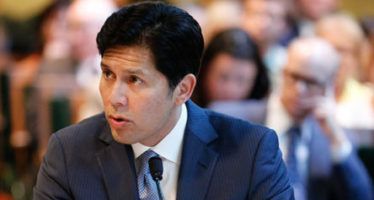Pension Debt Vastly Understated
OCT. 20, 2010
By DAVE ROBERTS
The Governmental Accounting Standards Board (GASB) is considering changing the rules for government pension reporting to better reflect the financial status of the plans, but critics say the proposed changes don’t go far enough to reveal the true cost to taxpayers of pension promises to government employees.
Currently GASB-adhering pension plans are required to reduce, or discount, the cost of projected pension benefit payments based on the expected rate of return on long-term investments of the plan’s assets. In effect, the discount rate allows the plans to reduce the current level of contributions from employees, school districts and state and local governments – ultimately, it’s all taxpayer dollars – by betting that that reduction will be offset by the plans’ investment gains.
The discount rate is 7.75 and 8 percent, respectively, for California’s two largest pension plans, California Public Employees Retirement System (CalPERS) and California State Teachers Retirement System (CalSTRS). The size of the discount rate is significant because most of a pension plan’s assets are tied up in investments – in CalSTRS’ case, approximately 60 percent of the funding for future benefits comes from investment returns and only 25 percent from contributions.
Pension actuaries are generally content with the current discount rate standard, feeling that it is a good reflection of the value of the pension plan based on the historical rate of investment returns.
But critics argue that because pension plan obligations are inherently without risk – retirees are legally guaranteed to be paid what they have been promised, regardless of how much money is in the plan – a risk-free discount rate should be used because it more accurately reflects the value of the plan’s liabilities (the payment obligations). Currently that’s in the area of 4 percent for high-quality municipal bonds.
The problem for pension funds is that using a lower discount rate would require significant increases in contributions to offset the reduction in investment gains. Studies using this risk-free discount rate standard estimate that California’s unfunded pension obligations might be anywhere from $327 billion to $500 billion – far more than the $75 billion shortfall currently projected by CalPERS and CalSTRS.
GASB, in its recently issued report, “Preliminary Views on Pension Accounting and Financial Reporting by Employers,” proposes a compromise. The discount rate would be the average of two rates: 1) the current long-term investment rate of return (7.75-8 percent) for current and future assets, and 2) the risk-free high-quality municipal bond index rate (currently about 4.25 percent) when assets are projected to be depleted.
The GASB report explains its reasoning for blending in the lower, risk-free rate: “In some cases, the assets held by a pension plan over time, including future contributions related to current employees and earnings, may not be expected to fully cover projected benefit payments. In such circumstances, the GASB does not believe that it is appropriate to use the [higher] rate of return on plan assets to calculate the present value of future benefit payments for which plan assets will not be available.”
CalPERS Deputy Executive Operation Officer Stephen Kessler in a letter to GASB goes along with the proposed blended discount rate standard while also asserting, “We believe that the most appropriate basis for discounting projected pension benefits to their present value for accounting purposes is the estimated long-term investment yield for the plan.”
CalSTRS Interim Chief Financial Officer Robin Madsen in her letter to GASB, disagrees with the proposal: “Conceptually, it seems inconsistent to use a blended rate composed of an investment rate of return for one portion of the liability and a borrowing rate [the risk-free municipal bond rate] for another.” She said it would be more logical to blend in the net investment rate, which is the difference between the cost of borrowing with state-issued bonds and the expected investment rate of return. For example, borrowing at 4 percent and assuming an 8 percent investment rate would equal a 4 percent net investment rate that would be blended into the discount rate.
But in a GASB hearing last week in San Francisco (one of three being held around the country), several investment economists gave the 11-member board an earful, arguing that the only rate that makes sense is the lower, risk-free rate.
David Crane, an economic advisor to Gov. Arnold Schwarzenegger, dubbed the proposed blended discount rate formula a “Rube-Goldberg like contraption.” He said that using the higher discount rate based on long-term investments only makes sense if the pension fund is not legally obligated to fulfill its promised payments to retirees.
“But that’s not the way it works,” he said. “Whether or not our state contributes to a pension fund, or whether or not there’s enough money in that pension fund, our state is on the hook for the pension payment. Our liability doesn’t change. In fact, should our state pension fund lose every penny, the only people in the state not adversely affected by that loss are pensioners, because they have that hell-or-high-water undertaking from the state, regardless of the pension fund’s status.
“GASB’s current accounting standard is based upon a fiction. That fiction being that the state is allowed to book an obligation as if it isn’t on the hook, even though it is on the hook. And, according to the Center for Retirement Research at Boston College, state and local governments are understating pension liabilities by $2.5 trillion as a result of this fictitious accounting treatment.”
Crane, who made similar remarks last month to the Securities and Exchange Commission, said that under-reporting of pension liabilities misled the state legislature into supporting pension increase legislation, SB400, which could result in an extra $150 billion hit to California taxpayers. “There are 14 legislators in our state legislature right now who were there in 1999 who tell me to a person had they known the truth in 1999, they would not have supported that pension increase,” he said.
“Let me close by making a plea. The value of a fully recourse obligation owed by our state should not be a complicated issue, yet somehow GASB has found a way to make it complicated. I don’t know why that is, but my plea is simply that you adopt plain-language and common sense reforms that tell the truth about the size of these obligations. These are the largest obligations owed by state and local governments, and I can guarantee you that few legislators have any idea about them. You must adopt clear and plain language accounting treatment so that laypeople understand them.”
Another financial economist supporting a risk-free discount rate, Barton Waring, called the current discount rate standard “moonbeam accounting” that GASB would not even be considering retaining were it not the status quo. “I think we all know what the right answer is,” he said. “The problem is we all know there’s a tremendous political issue that happens as soon as we acknowledge the true size of these liabilities, especially today. The liabilities are twice as large as they are (reported). Funding ratios go from bad to incredibly horrible overnight.
“The issue is one of transition. The decision should be: How do we handle the transition in a way that responsibly takes care of these pension plans and gets them through this crisis, as many of them as we can, in a way that allows them to continue on. Because these plans are in effect really funded today at about 40-50 percent economically. They cannot survive. They will survive for a few years. They will be falling over like tired, old elephants for lack of funding.
“The old saw that ‘Gosh, you can give any amount of benefits in a public plan because you can always go to the taxpayers.’ Howard Jarvis shows that pretty clearly here in California a few years back (that that no longer applies) with devastating results for our property tax system. We have to do something more responsible. It starts by telling ourselves the truth. I think the board knows what the right discount rate is, but it can’t get a grip on how to handle the political sensitivity of what happens with these liabilities and how do we maintain these plans. That’s the tough part.”
GASB Chairman Robert Attmore said during a break in the hearing that the board will probably take two years before it issues its final ruling. Asked about Crane’s concerns, Attmore said, “David has very strong beliefs and feelings about the particular issue that he testified about, and we appreciate that. We are here to learn from as many different perspectives as we can and go back and decide what we need to do in terms of revising the accounting and financial reporting requirements.”
Related Articles
Proposed pilot program could replace Caltrans with counties
Caltrans is on notice: A new bill looks at a life where counties would fix roads themselves. Responding to years of
CA gun control repeal effort builds
Gun rights groups have turned up the heat on Sacramento’s newest firearms restrictions, mounting an effort to repeal seven
Senate leader’s endorsement of Prop. 63 ammo measure lacks backstory
When Senate President Pro Tempore Kevin de Leon endorsed Proposition 63 last week, he didn’t mention the endorsement was conditional.




